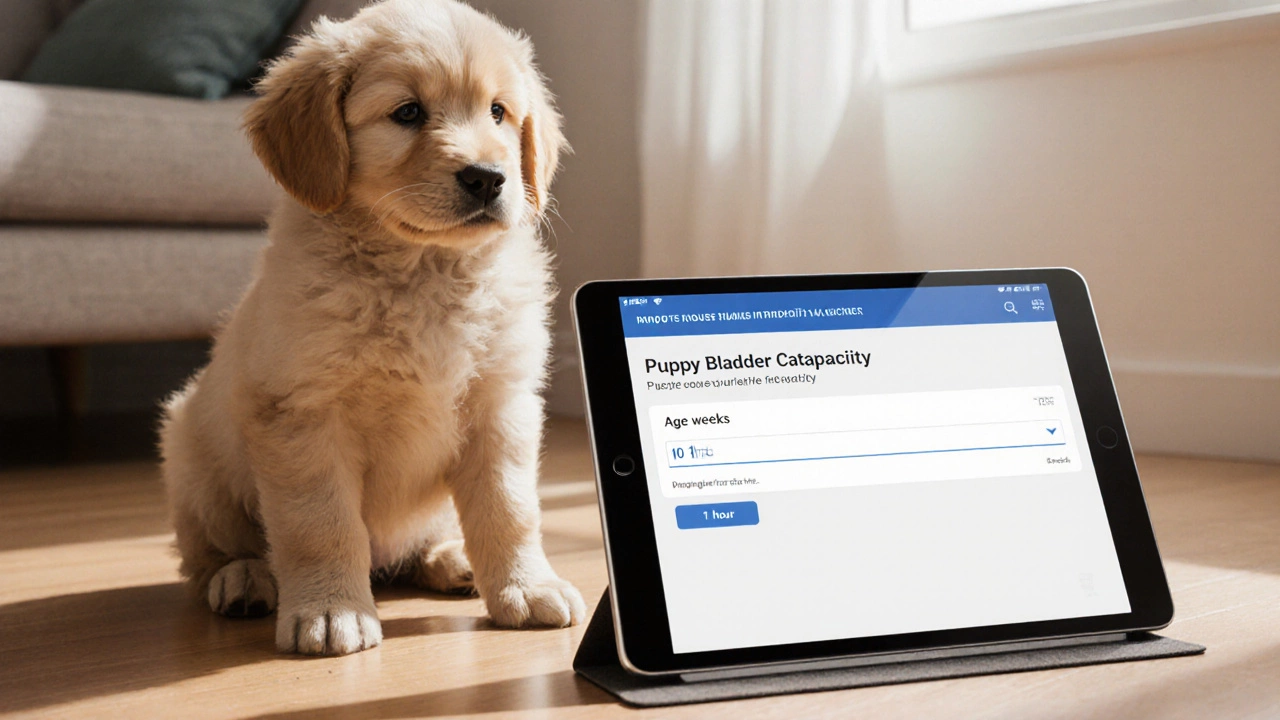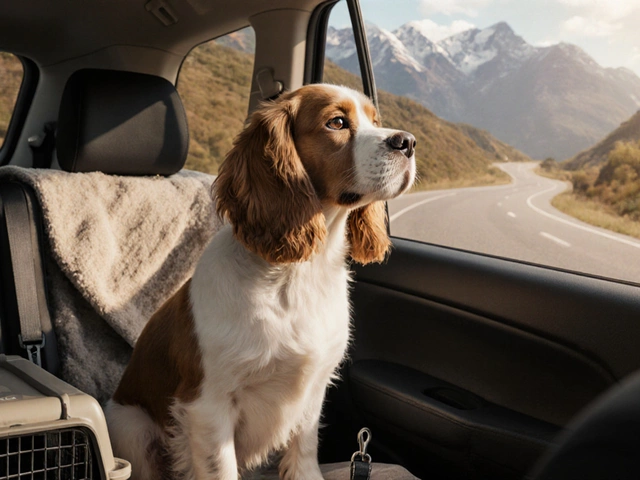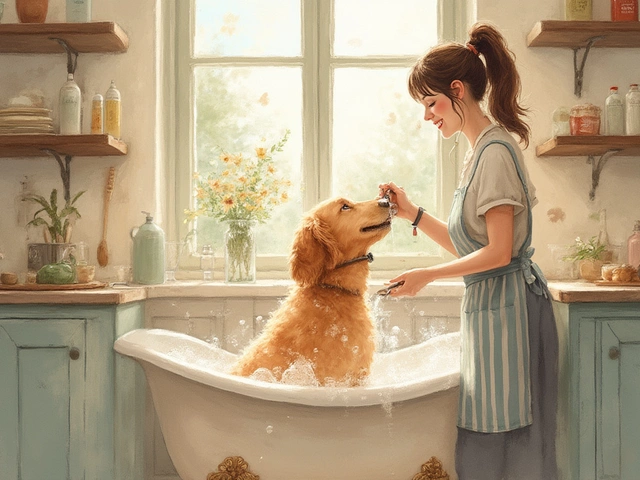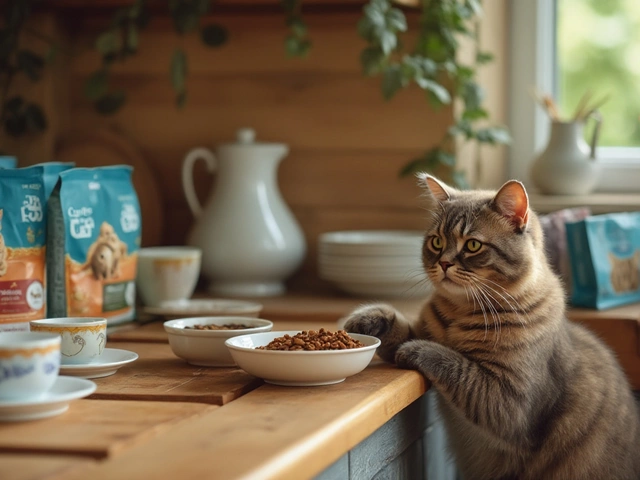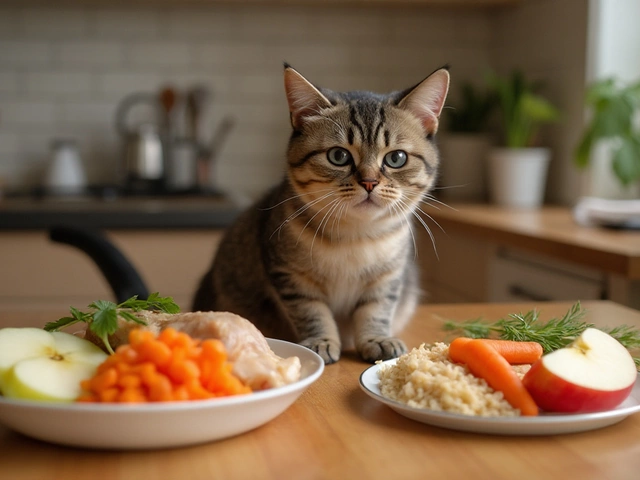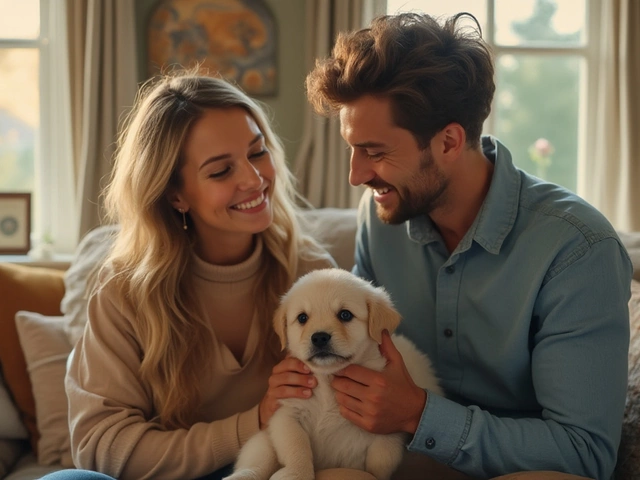Puppy Bladder Capacity Calculator
Training Tip
Take your puppy outside every 1 hour to prevent accidents. As your puppy grows, increase the interval by 30 minutes each month.
Bladder Capacity Information
A healthy puppy can hold its bladder for approximately 1 hour per month of age. For example, a 10-week-old puppy can hold it for about 1 hour.
Plan bathroom breaks accordingly to avoid indoor accidents. Remember to take your puppy out after meals, playtime, and upon waking.
Quick Takeaways
- Never punish after the fact; timing matters.
- Use a consistent schedule and a safe confinement space.
- Reward the right behavior, not the mistake.
- Clean accidents with an enzymatic cleaner to erase scent.
- Seek veterinary advice if accidents persist beyond the normal learning curve.
When it comes to puppy house training is the process of teaching a young dog where and when it’s appropriate to eliminate, using consistent cues, schedule, and positive reinforcement, many owners wonder if a little scolding can speed things up. The short answer: real punishment rarely works and often makes the problem worse. Below we break down why puppies pee indoors, the common pitfalls owners fall into, and the humane methods that actually get results.
First, understand the biology. A healthy eight‑week puppy can hold its bladder for roughly one hour per month of age, meaning a two‑month‑old can’t be expected to wait more than 60minutes. By twelve weeks, that window stretches to about two hours. These numbers are backed by a 2023 study from the University of Glasgow’s Veterinary School, which tracked bladder capacity in 78 puppies of various breeds. Knowing the limits helps you set realistic expectations and plan bathroom breaks before the puppy even feels the urge.
Positive reinforcement is a training technique that rewards the desired behavior instantly, increasing the likelihood the dog will repeat it. Instead of shouting or using a spray bottle, you give a treat, a happy voice, or a quick play session the moment the puppy finishes outside. The key is immediacy-within two seconds-so the pup connects the reward with the action, not with random moments later.
Many owners try to “catch” a puppy mid‑accident and scold it. The problem is that most dogs can’t link the scold to the earlier mistake. By the time you say “no,” the puppy may already be finished and is looking at you with confusion. That creates anxiety, and anxious puppies often soil more as they try to avoid the stress of being watched.
Crate training is the practice of using a properly sized enclosure to give a puppy a den‑like space that encourages it to hold its bladder until released. Dogs naturally avoid soiling their sleeping area. Choose a crate just large enough for the pup to stand, turn, and lie down-no extra room for a bathroom. Start with short periods while you’re home, gradually extending the time as the puppy gets comfortable.
Combine the crate with a potty schedule that mirrors the puppy’s natural rhythm. For example, take the pup out first thing after waking, after each meal, after play sessions, and before bedtime. A 2022 survey of 1,200 British dog owners reported that those who stuck to a strict schedule saw a 73% reduction in indoor accidents within three weeks.
Accidents will still happen. When they do, clean the spot with an enzymatic cleaner that breaks down urine proteins at the molecular level, eliminating odor cues that invite repeat marking. Ordinary bleach may kill bacteria but leaves a scent that a puppy can still detect, prompting another bathroom break in the same spot.
If the puppy continues to pee inside despite a solid schedule, a veterinary check is essential. Urinary tract infections, bladder stones, or even congenital issues can mimic training failures. Blood tests and a simple urine analysis can rule out medical causes in under an hour at most practices.
Another hidden factor is anxiety-particularly separation anxiety. Puppies that feel stressed when left alone may mark the house as a coping mechanism. Look for signs like excessive whining, pacing, or clinging before you leave. Addressing anxiety with gradual desensitization, safe chew toys, and a calm departure routine can reduce marking.
Above all, consistency is the practice of applying the same rules, cues, and rewards every single time you interact with the puppy. If one family member scolds while another rewards, the pup receives mixed messages and the learning curve stretches indefinitely.
Below is a quick reference chart that sums up the do’s and don’ts of correcting indoor accidents.
| Do | Don’t |
|---|---|
| Take the puppy outside immediately after a cue (doorbell, waking up, eating). | Wait to scold; the puppy won’t connect the punishment to the accident. |
| Reward with a treat or enthusiastic praise the moment the puppy finishes outside. | Rely on guilt‑inducing shouts or standing in the doorway. |
| Use a crate sized appropriately for the puppy’s age. | Leave the crate door open all day, turning it into a regular room. |
| Clean accidents with an enzymatic cleaner. | Use plain water or ammonia, which can attract repeat marking. |
| Maintain a consistent potty schedule. | Allow the puppy to “hold it” for longer than its bladder can manage. |
Implementing these steps creates a clear, positive learning environment. Most puppies graduate from frequent indoor accidents to full‑house reliability in 4‑6 weeks when owners stay disciplined.
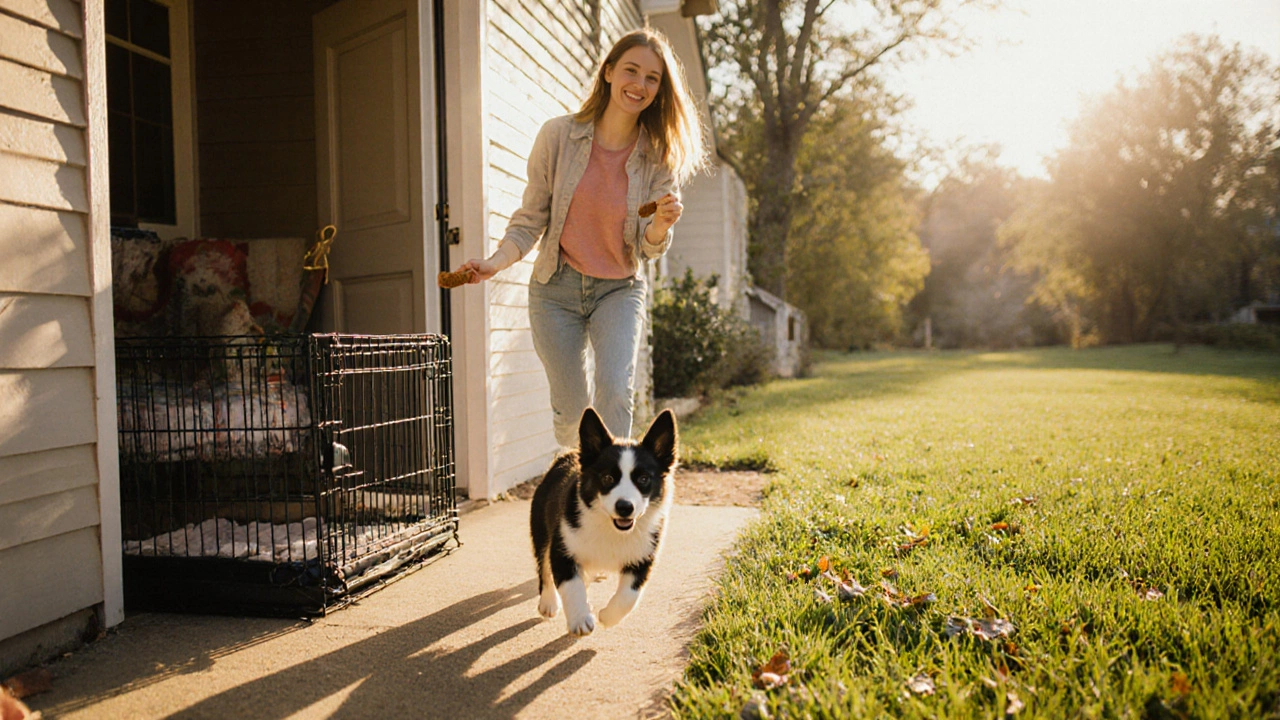
Step‑by‑Step Guide to Correct Indoor Peeing
- Identify the puppy’s current bladder capacity (approx. 1hour per month of age).
- Set up a crate that’s just big enough for the pup to turn around.
- Draft a potty schedule: first thing after waking, after each meal, after play, before bedtime.
- Choose a designated outdoor spot and use a marker word like “gopotty”.
- When the puppy starts to sniff or circle, gently guide it to the door; if you catch it in the act, calmly say “outside” and escort it out.
- Immediately reward with a high‑value treat and enthusiastic praise once the puppy finishes.
- If an accident occurs, blot the wet area, apply enzymatic cleaner, and note the time to refine the schedule.
- Review progress weekly; adjust the schedule as the puppy grows (add 30minutes extra hold time each month).
Remember, the goal isn’t to scare the puppy but to teach it a reliable routine. A calm, confident owner signals safety, and a safe pup is far less likely to stress‑mark.
When to Call in Professional Help
If after three weeks the puppy still has more than one accident per day despite a strict schedule, consider the following triggers:
- Visible signs of a urinary infection (blood in urine, frequent frantic trips to the door).
- Changes in behavior after a new family member or pet arrives.
- Persistent marking of vertical surfaces, which may indicate territorial behavior.
A certified canine behaviorist can conduct a functional assessment, while a vet can rule out medical issues. Investing in professional guidance often reduces the training period by up to 50%.
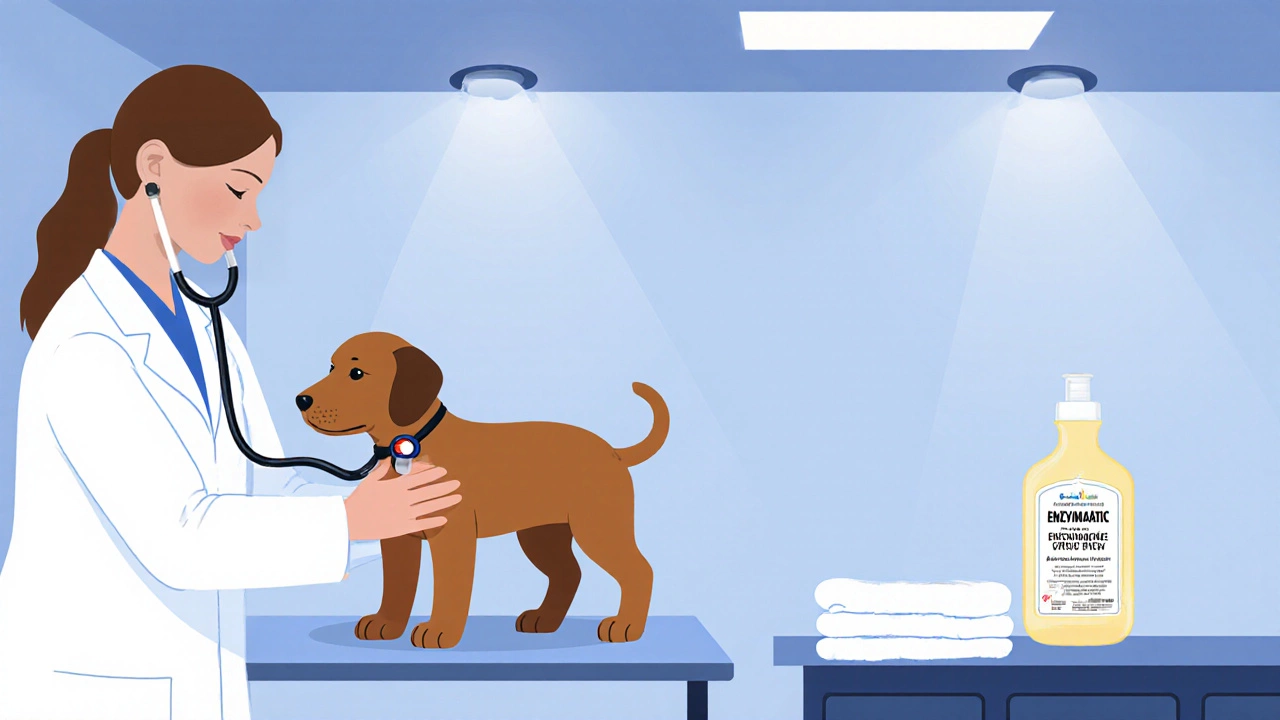
Frequently Asked Questions
Can I use a spray bottle as punishment?
No. A sudden spray can startle the puppy but won’t teach it where to go. It may also create fear of the bathroom area, leading to more accidents.
How often should I take my puppy outside?
Aim for every 1‑2hours for a 10‑week‑old, gradually extending the interval as the puppy ages. Always go after meals, play, and naps.
Is it okay to let my puppy sleep in a pen instead of a crate?
A pen can work if it’s small enough to act like a den, but many puppies treat a pen as a room and will eliminate inside. A properly sized crate typically yields better results.
My puppy keeps peeing on the carpet after I clean it. What’s wrong?
The carpet may still hold urine odor. Use an enzymatic cleaner specifically designed for pet stains, and consider a carpet protector until the habit is broken.
Should I reward my puppy if it pees outside too far from the door?
Yes. Reward any appropriate elimination; you can later guide the pup closer to the door as it learns the cue.
By focusing on timing, consistency, and positive reinforcement-rather than harsh punishment-you give your puppy the best chance to master house rules quickly. puppy house training isn’t about fear; it’s about building a clear, trusting routine that both you and your new companion can rely on.

